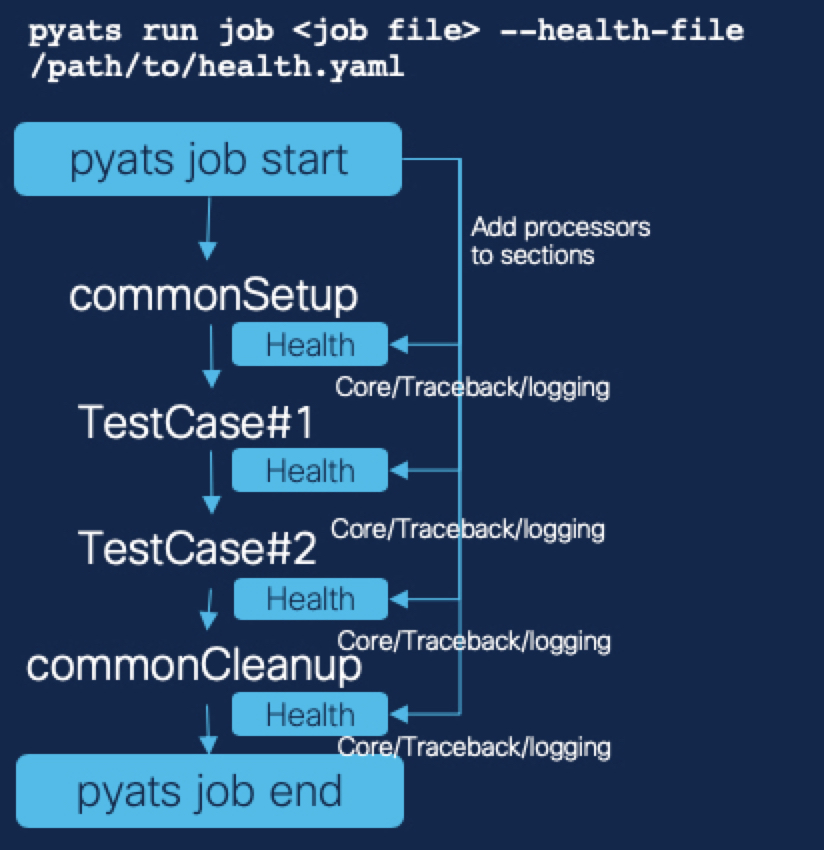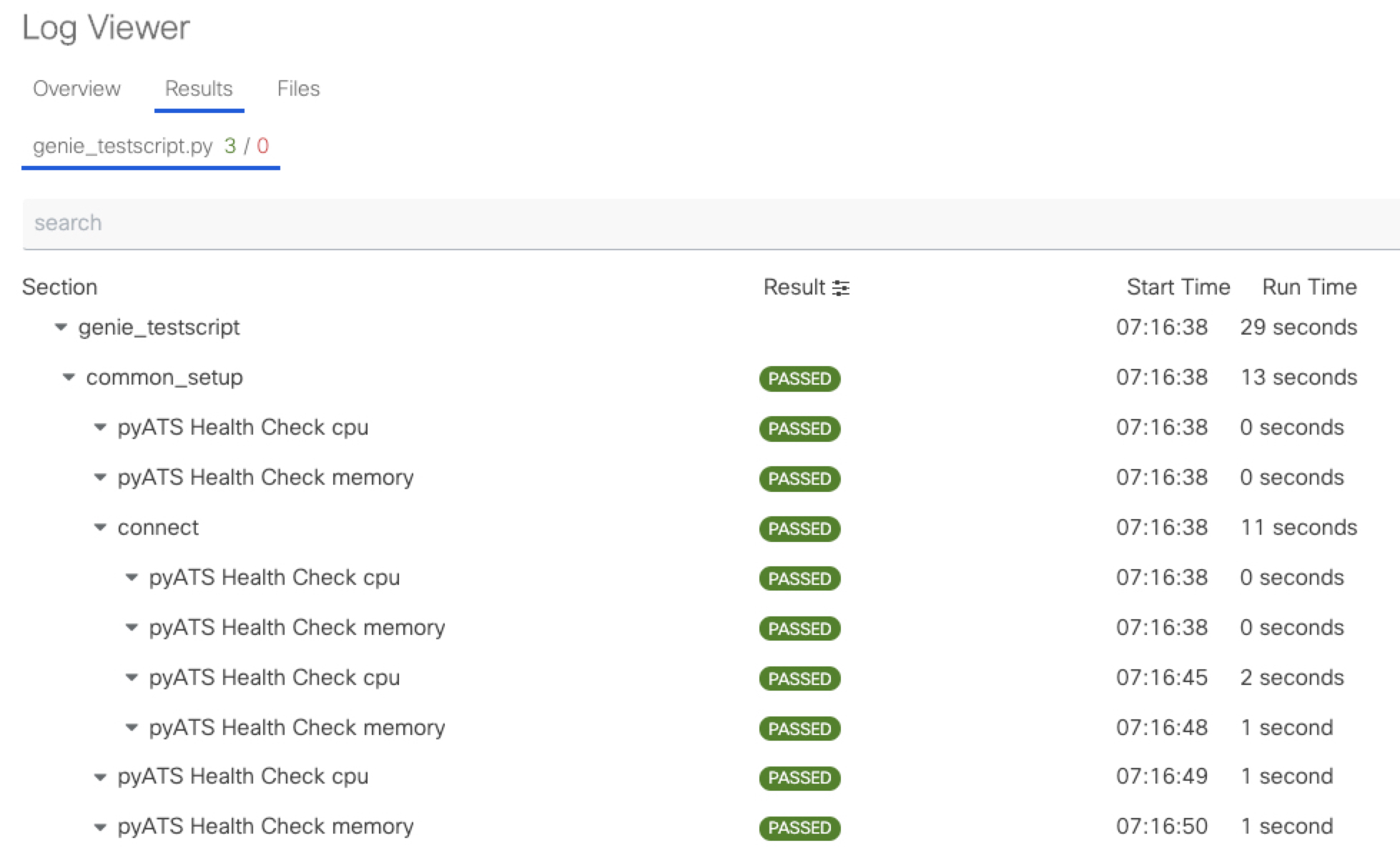Design
The previous page showed you how to use pyATS Health Check easily. This page is for those who want to use their own pyATS Health Check. If you are happy with the way it was done on the previous page, then please move on processor key in YAML.
You can collect and monitor the state of your devices as your testscript is executing with pyATS Health Check. It can collect traceback, core files, etc. pyATS Health Check is yaml driven and it is based on Blitz. All Blitz functionalities are supported in Health Check.
The health check is driven by a health_file which is provided at run time. There are two different mechanism to run the checks:
Part of a pre/post processor of a section or testcase.
Continuous data collection using a background process (Coming with 21.7).
To use your own pyATS Health Checks, you can specify pyATS Health Checks by leveraging the existing Blitz style YAML format as it uses the same format and capabilities that Blitz has. The actions in pyATS Health Check yaml will be added to pyATS job’s sections as pre/post processors. Execution of the actions as pre, post or both can be specified in the yaml.
Note
See the detail of Blitz
# Quick start Guide!
# ------------------
# 1. Create the health yaml
# 2. Add `--health-file` argument to pyats command
# 3. Run the job and verify issues found by the pyATS Health Check if any
# Integrated with pyATS jobs
pyats run job <job file> --testbed-file /path/to/testbed.yaml --health-file /path/to/health.yaml
Note
Devices for pyATS Health Check need to be specified in the health yaml file and the testbed yaml for the pyATS job to execute health checks against the device.
The pyATS testbed object will be converted to Genie testbed object to have Genie functionalities.

Create health.yaml with knowledge about pyATS Blitz and then add the argument --health-file with the filename. pyATS Health Check will add Blitz actions as processors to sections in pyATS job. pyATS Health Check processors will run before and after each section (as specified) to monitor/collect device status as specified in the health yaml file.
Even for development of health yaml, the health file makes developer’s life easier. It’s the same format as the Blitz format and the health file can run like Blitz as well. So, develop and test as Blitz first and just switch the argument from --trigger-datafile to --health-file when health yaml is ready.
pyATS Health Check comes with default checks; however it is fully open-sourced! You can add your own checks to be executed at any time! Any features or functions to monitor, those can be contributed and developed as Blitz actions or APIs.
Note
See all the available APIs for pyATS Health Check Available Apis
pyATS Health Check’s added processors can be easily found in pyATS or XPRESSO logviewer. The processor results are added with a pyATS Health Check label and also icons for both Pre and Post.

pyATS Health Check is highly flexible and extendable. One of the biggest advantage is, leveraging Blitz style YAML format. Whatever can be possible in pyATS Health Check as long as it’s supported/implemented with Blitz way.
Develop testcase(trigger-datafile) with Blitz and develop pyATS Health Check yaml with same way! It’s very straight forward and very quick to start pyATS Health Check!
Note
See the detail of Blitz
pyATS Health Check yaml
Here is the pyATS Health Check yaml. It’s almost same with Blitz! There are a few consideration to run it as pyATS Health Check. All the things are written as below comments in the yaml. If no comments, it means these items are exact same with Blitz.
# testcase name should be `pyats_health_processors`
pyats_health_processors:
groups: ["test"]
# specify pyATS Health Check class instead of Blitz one
source:
pkg: genie.libs.health
class: health.Health
test_sections:
# section name. this name will appear in Logviewer
- cpu:
- api:
device: uut
# `processor` is only for pyATS Health Check. Not for Blitz
# Explained the detail in next section
processor: both
# `function` can be found from Genie Feature Browser
# Please find the link to the page from bottom of this section
function: health_cpu
arguments:
command: show processes cpu
processes: ['BGP I/O']
- memory:
- api:
device: uut
processor: post
function: health_memory
arguments:
command: show processes memory
processes: ['\*Init\*']
include:
- sum_value_operator('value', '<', 90)
Note
All available APIs and Parsers can be found here Genie Feature Browser
processor key in YAML
processor key is introduced for pyATS Health Check. It enables you to control if the section in pyATS Health Check run as pre and post processor , pre-processor, or post-processor.
Here is the list of options for processor key in YAML and how it works.
If no processor key in YAML is given, default is both. So, pyATS Health Check attach the sections/actions as both pre and post processors to pyATS job.
processor |
behavior |
|---|---|
both (default) |
run as pre and post processor |
pre |
run as only pre processor |
post |
run as only post processor |
post_if_pre_execute |
run as post processor. But it requires pre processors run before |
Regarding post_if_pre_execute, sometimes post-processors need result/information from pre-processor. For example, get a route in pre-processor and verify the route in post-processor. In that case, the post_if_pre_execute is useful to make sure pre-processor is done before.
reconnect feature
reconnect feature can be enabled in YAML, which is useful when device is crashed/reloaded. And it’s very easy to use. If you want to reconnect to device in case device is disconnected due to crash/reload/etc, just add below one line in health yaml.
pyats_health_processors:
source:
pkg: genie.libs.health
class: health.Health
reconnect: # <<<<<
test_sections:
- traceback:
- api:
By default, reconnect max_time 900 secs and interval 60 secs. max_time is for how long pyATS Health Check is going to retry the reconnection. interval is sleep time between attempt of reconnection when the previous one failed.
The max_time and interval can be configured by adding those under reconnect section like below.
pyats_health_processors:
source:
pkg: genie.libs.health
class: health.Health
reconnect:
max_time: 360 # <<<<<
interval: 45 # <<<<<
test_sections:
- traceback:
- api:
Selecting Testcase/Section
pyATS Health Check processors are running before and after every testcase and section by default.
However, you can select which testcase and which sections to execute pyATS Health checks.
There are four ways to select where health checks run. By default pyATS Health Checks run before and after every testcase and section. With the filtering you can decide where they are executed.
These arguments can be provided either via the CLI or via the Health YAML file.
- Testcase level:
--health-tc-uids/health_tc_uids Provide the testcase/trigger names from Testcase/Trigger datafile. The exact name can be provided or regular expression is also supported. pyATS Health Check processors will run only for the given testcase/trigger names which match the full name or match the regex.
- Testcase level:
- Section level name:
--health-tc-sections/health_tc_sections Provide the section name. The exact name can be provided or regular expression is also supported. pyATS Health Check processors will run only for the given section name which match the full name or match the regex. It will not run at the testcase level.
- Section level name:
- Section level type:
--health-tc-sections/health_tc_section Provide the section type. The following types are supported:
CommonSetup
CommonCleanup
SetupSection
CleanupSection
TestSection
TestCase
# Section level type filter example health_tc_sections: - type:CommonSetup
- Section level type:
- Group:
--health-tc-groups/health_tc_groups Provide the group name from Testcase/Trigger datafile. The exact name can be provided or regular expression is also supported. pyATS Health Check processors will run only for the given section name which match the group or match the regex.
- Group:
CLI example
pyats run job <job file> --testbed-file <testbed file> --health-file /path/to/health.yaml --health-tc-uids <testcase name> --health-tc-sections <section name> --health-tc-groups <testcase group>
Health yaml example
test_sections:
- cpu:
- api:
device: xe
function: health_cpu
arguments:
command: show processes cpu
processes: ['BGP I/O']
include:
- sum_value_operator('value', '<', 90)
health_tc_sections:
- check_cpu
health_tc_uids:
- Test.*
arguments |
behavior |
|---|---|
–health-tc-uids |
provide testcase/trigger name from trigger datafile. regular expression is supported. pyATS Health Check processors will run only for the given testcase/trigger names from trigger datafile which meet the regex. |
–health-tc-sections |
provide section name. regular expression is supported. pyATS Health Check processors will run only for the given section name which meet the regex. |
–health-tc-groups |
provide group name from trigger datafile. regular expression is supported. pyATS Health Check processors will run only for the given group name which meet the regex |
All the arguments can be given to pyats run command or only one or two.
pyats run job <job file> --testbed-file <testbed file> --health-file /path/to/health.yaml --health-tc-uids <testcase name> --health-tc-sections <section name> --health-tc-groups <testcase group>
pyats run job <job file> --testbed-file <testbed file> --health-file /path/to/health.yaml --health-tc-uids <testcase name>
pyats run job <job file> --testbed-file <testbed file> --health-file /path/to/health.yaml --health-tc-uids <testcase name> --health-tc-sections <section name>
When multiple arguments are given, the multiple arguments works as double/triple filters. It means targeted testcase/sections are narrowed down by multiple arguments.
Example1 (only --health-tc-uids for testcase Testcase1):
pyats run job <job file> --testbed-file <testbed file> --health-file /path/to/health.yaml --health-tc-uids Testcase1
Example2 (only --health-tc-sections for section show_version):
pyats run job <job file> --testbed-file <testbed file> --health-file /path/to/health.yaml --health-tc-sections show_version
Example3 (both --health-tc-uids and --health-tc-sections for section show_version in testcase Testcase1):
pyats run job <job file> --testbed-file <testbed file> --health-file /path/to/health.yaml --health-tc-uids Testcase1 --health-tc-sections show_version
The arguments to pyats run command will be effective all the sections/actions in health yaml.
In health yaml, same arguments(health-tc-uids/health-tc-sections/health-tc-groups) can be specified in each action in health yaml. And the behavior is same with above arguments to pyats run command. only difference is the arguments will be effective for the action.
test_sections:
- cpu:
- api:
device: xe
function: health_cpu
arguments:
command: show processes cpu
processes: ['BGP I/O']
include:
- sum_value_operator('value', '<', 90)
health_tc_sections:
- check_cpu
In case of above, health_tc_sections is given to api action. This api action will run only for the section check_cpu in all Testcases/Triggers.
This way has more flexibility because pyATS Health processors can be controlled per action in health yaml.
Note
When arguments to pyats run command are given, the arguments will be preferred against health yaml.
When multiple items are given to each argument in health yaml, those multiple items will be used as OR search
Result propagation
pyATS Health Check pre processor will not affect to section result even though some of actions in pyATS Health Check don’t meet criteria in health.yaml because pyATS Health Check itself is kind of monitor/collect functions. So, pyATS Health Check shouldn’t affect the section run. Any prerequisite things need to be handled in testcase itself instead.
However, the pyATS Health Check pre processor result will pass to pyATS Health Check post processors and the result will reflect to section with post processor result at end of the section.
If one of either pre or post processor items is failed, the result reflect to section even though the section is passed. So that user can look into the section and pyATS pre/post processors what happens. When reflecting pyATS Health Check processor result to section, same Results Rollups occurs. Please check the Results Rollups to below note.
Note
See the detail of Results Rollups Results Rollups
Supported Platforms for pyATS Health Check
If you can connect to it; the infra supports it. You can use any of the existing APIs/Parsers.
Note
See the Supported Platforms by Unicon Supported Platforms
See all the available APIs Available Apis
See all the available Parsers Available Parsers